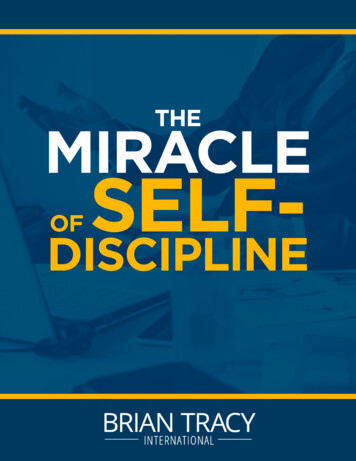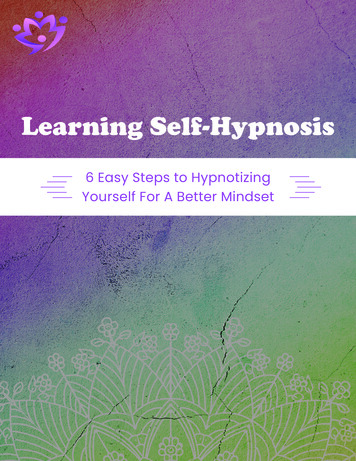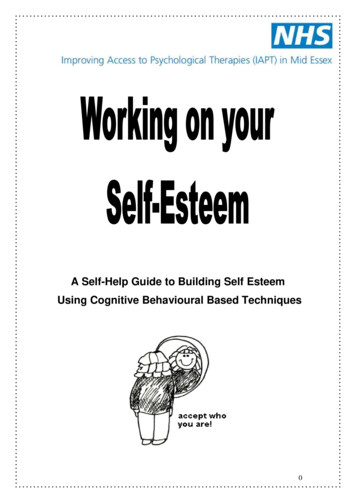
Transcription
BESTSELFBE YOU, ONLYBETTERMIKE BAYER
The information in this book has been carefully researched by the author and isintended to be a source of information only. While the methods contained herein canand do work, readers are urged to consult with their physicians or other professionaladvisors to address specific medical or other issues that may be preventing readers frombecoming their best selves. The author and the publisher assume no responsibility forany injuries suffered or damages or losses incurred during or as a result of the use orapplication of the information contained herein.Names and identifying characteristics of some individuals have been changed topreserve their privacy.best self. Copyright 2019 by Michael Bayer. All rights reserved. Printed in theUnited States of America. No part of this book may be used or reproduced in anymanner whatsoever without written permission except in the case of brief quotationsembodied in critical articles and reviews. For information, address HarperCollinsPublishers, 195 Broadway, New York, NY 10007.HarperCollins books may be purchased for educational, business, or salespromotional use. For information, please email the Special Markets Departmentat SPsales@harpercollins.com.first editionLibrary of Congress Cataloging-in-Publication Data has been applied for.ISBN 978-0-06291173-519 20 21 22 23 LSC 10 9 8 7 6 5 4 3 2 1
Here is a list of positive traits to consider. You can circle onesthat apply to you or add them to your own fairhelpfulat itfulinnovativecarefuldignifiedfullinoffensive1
nethoughtfulkind to otherspolishedsatisfiedtidykind inner portive2
Anything about yourself that you find to be a positive attribute, that you don’t see above, write down below:My Best Self TraitsIt can be tough to write down our best traits because we don’texactly sit around thinking about how great we are constantly.That’s not human nature. We’re far more prone to pick ourselvesapart. But hopefully by the end of this book, you will be trulyembracing and acknowledging all your best traits—it is a far moreproductive and proactive activity!Soon you’re going to be looking at yourself objectively, as ifyou’re on the outside looking in, and really seeing yourself, maybeeven for the first time. This requires a heightened self-awareness,so it might take some time. You may even want to ask a trustedconfidant, if you have one, for some help in getting started. If youdo, just make sure that person has no agenda, and only wants youto be at your best.3
Exercise: Create Your Best SelfRefer back to the list of traits you just wrote down, the ones youlike most about yourself. These will help you give shape to yourBest Self character. I want to take a moment here to remind youthat this should be fun; you can infuse this exercise with humoror you can be serious. Whatever you feel.These questions can help you get started:Is your Best Self: A particular gender? An animal? A mystical creature? Or a wise voice inside yourself? A character inspired by a book or movie?Does your Best Self have a motto or tagline?Does your Best Self behave in a particular way when someoneis being kind to you?Does your Best Self behave in a particular way when you’refeeling threatened?What does your Best Self believe about you?Does your Best Self move/walk/dance in a specific way?What is your Best Self’s #1 superpower?Now, write a full description of your Best Self here:4
Draw your Best Self here:5
How Are You Coaching Yourself?Folks typically hire me as a life coach because they want to improve an area of their life; they’re usually stuck in place and needhelp getting unstuck or finding a new perspective. The role of a lifecoach varies—but any good one will not only help you identifyyour goals, but also coach you on how to get them. They shouldalso hold you accountable to what you want to create in their life.As you will see throughout this book, I will also coach youtoward identifying your blind spots and booby traps because theycan be problematic. I like to ask folks if they have clear goggles.What I mean by that is if they are looking out with clear focus, ortheir vision is being blurred by their ego. We all have behaviors orthought patterns that are negatively impacting our lives and preventing us from evolving and growing. Some examples are whenwe lack humility or have an insatiable need to be right. Now is thetime to confront them and, if they are not serving you in a positiveway, release them and replace them with positive ones. Or, if youhave a tendency to set yourself up for failure in certain areas ofyour life, we’ll also put a stop to that. Since I won’t be by your sideto talk through every decision you need to make, make sure yougive some “life coach” qualities to your Best Self character so thathe or she can step up in my place for the rest of your life.Here are some questions to get you thinking like a Life Coach: How will your Best Self help you remain fearless? How will your Best Self help you to feel no shame about whoyou are in this life? How will your Best Self help you remain honest with yourselfand others? How will your Best Self help you maintain that kind,compassionate inner voice at all times?6
How will your Best Self help you feel empowered in allsituations? How will your Best Self help you remain grateful? How will your Best Self help you feel free to be who you trulyare?Write out the “life coach” characteristics of your Best Self here:7
’s Gratitude ListI am grateful for . . .1.2.3.4.5.6.7.8.9.10.8
Here is a list of common Anti-Self traits to consider. You cancircle ones that apply to you or add them to your own atorydomineeringimpulsiveoverlyopinionated9
rousunintelligentAnything about yourself that you find to be a negative attribute, and that you don’t see above, write down below:Anti-Self TraitsCreate Your Anti-SelfReferring to the negative traits you wrote about above, let’s nowbegin to give shape to your Anti-Self. As you dip into your imagination for this exercise, remember that this is meant to be an exag10
geration of this version of yourself. I believe it’s healthy to be ableto laugh at ourselves, if only a little. If we’re so tightly wound thatwe can’t poke fun at ourselves at times, then we’re just taking ourselves too seriously. Also, the overexaggeration of our traits helpsus remember them. Thus, when we think or behave in a certainway, we can stop and assess: “Am I acting out of my Best Self, ormy Anti-Self?” And we have powerful imagery attached to both.One of my Anti-Self characters is “Angelos.” He loves to provoke people, he’s impatient, and he really rears his ugly head whenever he feels like people are being dishonest. He lacks compassionand refuses to accept that some folks will tell white lies out oftheir own fear. He’s impulsive. He can’t stand news, weather, andsports conversations. He is untrusting. My friends know aboutthis character and they have pointed him out to me in the past,but I can honestly say that Angelos’s volume is low to non-existentthese days.As you work on fleshing out your Anti-Self, keep in mind thatit’s perfectly fine if you need to create several different charactersthat are various versions of your Anti-Self. You can give each ofthem their own set of qualities and appearances.In the same way that a screenwriter fully fleshes out his or hercharacters before writing a word of dialogue in a movie script, Iwant you to have a full, complete picture and understanding ofwho your Anti-Self character is. The clearer the image is in yourmind, the easier it will be for you to predict what might triggerhim or her to react or influence your behavior. And it will alsohelp your Best Self in keeping him or her at bay.Here are some questions to get you started on creating yourAnti-Self:11
Is your Anti-Self: A particular gender? An animal? A mystical creature? A character inspired by a book or movie?Does your Anti-Self have a tagline?Does your Anti-Self move/walk/dance in a specific way?Does your Anti-Self behave in a particular way when someoneis being kind to you?Does your Anti-Self behave in a particular way when you’refeeling threatened?What does your Anti-Self believe about you?What does your Anti-Self wear?Write a full description of your Anti-Self here:Name five recent events or situations when you know your AntiSelf was taking charge of the situation.1.2.3.4.5.Now, grab a pen or pencil, marker, or paintbrush; it’s time tosketch out your Anti-Self. Get as detailed as you can!12
Draw your Anti-Self character here:13
Before we go on, take a moment to assign a name to your AntiSelf and write it at the top of the image you created.Now ask yourself how you would handle those five situations ifyou were acting as your Best Self. In other words, what would yourBest Self tell you differently if he or she were in charge instead?1.2.3.4.5.14
What ChargesYour Authenticity Battery?What were you doing the last time that you felt truly alive, likeyou were firing on all cylinders? When you felt like you were fullyplugged in to your life?The answers to those questions may pop right into your mind,allowing you to relive those moments. Alternatively, you mightstill be scratching your head and wondering if you’ve ever reallyfelt that way. But having those moments of ultimate rejuvenation,feeling fully charged, is what I like to call charging your authenticity battery. These moments are key in your life, and necessary.Let’s explore together and discover what it is that charges yourauthenticity battery. Right now, take a moment to think about what makes youfeel truly alive and write it here: When was the last time you did that activity? Based on the type of activity that you’ve identified ascharging your authenticity battery, what does this tell youabout your Best Self?15
What areas of your life match up with your Best Self? What areas of your life do not match up with your Best Self?When you look at the information you wrote down above,does it seem as though what you do in your life mostly matchesup with who you are authentically? If so, that’s exciting becauseit means our work together will be focused on fine-tuning and/orworking problems in specific areas.On the other hand, does it seem more like you’ve buried yourcore self under piles of the messy stuff in life? That’s okay too,because we’re about to start digging!Now, Rate Your Readinessfor ChangeIt’s time to start your journey. Are you really ready? I’d like for youto rate yourself, on a scale of 1–10, on the five factors we’ve beendiscussing: curiosity, honesty, openness, willingness, and focus.1 Not at all 5 Getting there 10 100%, I’m all in!How curious are you to learn about who you really are, even if youmight find that person to be different from who you are right now?1.CIRCLE ONE:1234 567 891016
How honest are you going to be with yourself as you do the exercises in this book? Will you shine a bright light on every corner ofyour life and mind?2.CIRCLE ONE:1234 567 8910How open are you to making changes necessary in order to improve your life?CIRCLE ONE: 1 2 3 4 5 6 7 8 9 103.How willing are you to go to whatever lengths are necessary toimprove your life and create a consistent connection with your BestSelf?CIRCLE ONE: 1 2 3 4 5 6 7 8 9 104.How focused are you on the tasks at hand within the pages andexercises in this book?CIRCLE ONE: 1 2 3 4 5 6 7 8 9 105.If you did not circle 10 on all of these questions, ask yourself this:what do you need to do right now in order to reach a 10? Write itdown here:17
Fear Inventory QuizAll too often in our lives, we succumb to fears. We may not realizethat fear is at the heart of something that we’re allowing to stand inour way, so an imperative step is to examine what’s holding us backand find out whether fear is at the heart of it. Franklin D. Rooseveltfamously said in his inaugural address, “The only thing we have tofear is fear itself.” Why is that? Fear is a liar. It would have you believe that you are not good enough, that you are not capable enough,that everyone is judging you, and then you act accordingly. Mostof the time, the things we are afraid of never even occur. Imaginethat—we are spending time and energy worrying about somethingthat never plays out. What if we were able to use that brainpoweron positive action, on something that helps us move forward in ourlife, instead of making us stand still, stuck right where we are? Wecan. It’s possible. It begins by getting honest with ourselves aboutour fears so that they can’t become entrenched in our minds.I don’t want any fears standing between you and your BestSelf, so let’s take the time to identify them and then tackle them,one by one.Part 1: What are you afraid of?We’re going to start this process off with a little free association.I’m going to ask you a question, and I want you to start writingdown all the words that come to mind immediately after you readit. Don’t hesitate for even a moment—just start writing. And don’tstop until you run out of words or start repeating them.Looking at what we are afraid of is a vital step in this process,though it’s a very powerful and often emotional exercise. It’s toughshining a light on your fears, but it’s so worth it in the end. Allof us, at some point in our lives, have allowed fear to have power18
over us in some way. Once you’ve mastered the ability to recognizewhat triggers your fear as well as, crucially, when it starts, you cankeep fear from taking root and actually shaping your life. You callthe shots in your life, not fear. So, let’s clear out the fear!Ready? Good. Now, here’s the question:What are some of the fears that have held you back from makingchanges in your life?Part 2: Fear PatternYou may not have realized that some of those fears were prowlingaround in your mind, or maybe you’ve just been avoiding them.What I want you to know right now is that you are not alone.Other people have overcome these same fears. You can, too. Bybeing bold and brave enough to bring those fears to the forefront,you’ve just taken the first step in facing them down. Now, let’stake the next step.Looking at your list, do you notice any patterns? Can you easily group several of your fears into broader categories such as humiliation, worthlessness, or lack of approval? Maybe most of yourfears boil down to the notion of you not being lovable or valuableto others? When you look at the list, does one overall theme seemto be present? For instance, does the through-line seem to be thatyou’re afraid you can’t stick with the plan required for your lifeto change? Or are you petrified of failure? Of what other peoplethink? That you don’t deserve better? Take a close look and thenwrite down what you see.19
The overarching reason I’ve been afraid to change is:Part 3: Put Your Fear to the TestYou’re doing great—look how much you’ve just learned aboutyourself in a matter of minutes! When we really start asking thesequestions, we begin to understand ourselves and our motivationson a whole new level. Now, let’s build on the great work you’vedone so far.Think of your brain as a muscle. In the same way you can goto the gym and strengthen your biceps through training, youcan train your brain. In fact, whether you’re doing it purposelyor not, you’re constantly training your brain to think in certainways. Taking that concept a step further, it could be that you’veinadvertently trained your brain to be afraid of things that youdon’t need to fear. That’s right; you might be operating everysingle day and making decisions around a fear of something thatisn’t real.For the sake of clarity, I’ll give you a simple example. Let’ssay you are preparing for a presentation at work. You’ve preparedyour talking points, you’ve done your research, and you know justwhat you want to say. But every time you go to practice the talk,you freeze up, paralyzed with fear. You’re imagining all of yourcoworkers laughing out loud as you stand at the head of the conference table. You see yourself showing up to the meeting naked.You fixate on a certain point you want to make and get tonguetied every time you try to utter it. The reality is—it’s a two-minutepresentation that is well within your abilities and experience, but20
your mind is caught up in a sticky spiderweb of fears run amok. Ifyou believe the lies that your fear is telling you, it can have real-lifeconsequences.In your everyday life, are you spending valuable time and energy being afraid of something that isn’t real and poses no actualthreat to you? Are you letting it drive your decision making on abig scale? Has your imagination gotten the best of you?Refer to your answer in Part 2—the reason you’ve been afraidto change. Now, let’s test that fear:1.2.3.Is it factually true?Does it serve your best interests?Does it generate progress toward healthy goals?These questions can help you determine if your fear is rationalor not.For example, if you’re miserable in your job and you want tostart your own business, have you been afraid that you won’t beable to make ends meet or you’ll lose everything? That could bea very rational fear, but there is a way to address it. What is going to help you overcome that fear and start that business? Theanswer is a financial safety net. In this case, you’ve identified afear of financial ruin, so the way to prevent that fear from becoming a reality is to save up enough money that you can survive fornumber of months (you fill in the blank with what makesyou comfortable) before you quit your current job. In so doing,you’ve mitigated the risk and effectively abolished that fear. Nowthat you’ve moved that fear obstacle out of the way, you can confidently continue on your journey toward being your own boss.So, now I want you to write down your rational, legitimatefear, what it’s stopping you from doing in your life, and then create a plan that you can put into place to prevent the fear frombecoming a reality.21
My fear is:It is keeping me from:My plan for preventing my fear from becoming a reality is:Here’s an example:Being rejectedIt is keeping me from: Trying new things, meeting new people,and allowing life to work itself out. It causes anxiety when Ihave to meet new people, it makes me feel like I’m not myselfwhen I’m around coworkers because I’m wanting them to likeme, and I feel the need to try to control everything.My fear is:My plan for preventing my fear from becoming a reality is: Toremind myself when I feel rejected that life is trying to deliversomething new and better, and to find happiness in that belief.Do this as many times as you need for as many fears as arestanding in your way. Once you’ve got a plan in place for eachone, you have taken the power away from the fear and thereforerendered it powerless.22
Part 4: Faith Beats Fear Every TimeI believe the opposite of fear is faith. There’s an old English proverb that I had inscribed on a key chain years ago. It says, “Fearknocked at the door. Faith answered. No one was there.” If youhave faith that things are going to work out and faith in yourselfthat you are capable of doing what’s required, then you take allpower away from your fears, and in fact, your fears cease to exist.For many people, getting past our fears is a matter of letting go ofthem and replacing them with faith.The next time you recognize that fear has crept in and is keeping you from positive change, try this visualization technique:1.2.3.4.5.6.7.8.Close your eyes and imagine the fear. Gather up all thevisual images in your mind that accompany the fear, aswell as the negative feelings it produces within you.Now put all of those items inside a big, cardboard box inyour mind.Then, make the box smaller, and smaller, and smalleruntil it fits right into the palm of your hand.Now imagine yourself standing at the edge of a giantcanyon, so deep that you can’t see the bottom.Throw the box in and watch it fall until it’s out of sight.Imagine yourself turning around, and when you do,there’s an outdoor shower.Turn on the water, and let a warm, loving sensation washover your entire body.Open your eyes and embrace the feeling of beingrefreshed and renewed by your faith.You can return to this visualization anytime you need to, asit can strengthen you and help you have freedom over your fears.23
Exercise: Self-Affirmations Look in a mirror or your phone. Typically, when we look inthe mirror, we are purely looking at our aesthetics: the outfitwe’re wearing, our hair, or maybe we even zero in on a molewe should have checked. But for our purposes, you’re lookingbeyond aesthetics. When was the last time you looked, and Imean really looked, into your own eyes? What do you see? Who are you? What are some things thatyou truly love about yourself? Do you see someone who isstrong? Kind? Generous? Loyal? Loving? Funny? Outgoing?Quiet? Think about words that describe not how the worldsees you, but how you see yourself, positive words that aretrue about you, on every level. The ego inside of you may make this difficult in that itmight make you drift away from your positive attributes andtoward negative aspects. You might even think somethingpositive like “I’m a loving person,” but then that ego voicepops up and says, “Yeah, but if people really got to knowyou, they’d discover you’re not that lovable.” Be aware of thatvoice. Write down 5–10 truths about yourself, starting with thephrase “I am . . .” Fill them in here:1.2.3.4.5.6.7.I amI amI amI amI amI amI am24
8.9.10.I amI amI amNow, say these sentences out loud to yourself, while looking inthe mirror.The first time people try out self-affirmations, they can be alittle intimidating or even make you feel foolish, but I promise itgets easier with time. They are a cornerstone of the work we’ll bedoing together because they get to the heart of who you are inside,and they help you stay connected to your Best Self.25
Social Skills InventoryThe following inventory exercise can help you take a step back andlook at how you interact with others in an objective manner. Asyou go through, make sure you fully understand each statementbefore you answer, and then answer as honestly as you can.26
PART 1:Sending Clear MessagesUSUALLYSOMETIMESSELDOM1. Is it difficult for you to talk to otherpeople?2. When you are trying to explainsomething, do others tend to put wordsin your mouth, or finish your sentencesfor you?3. In conversation, do your words usuallycome out the way you would like?4. Do you find it difficult to express yourideas when they differ from the ideas ofpeople around you?5. Do you assume that the other personknows what you are trying to say, andleave it to him/her to ask you questions?6. Do others seem interested andattentive when you are talking to them?7. When speaking, is it easy for you torecognize how others are reacting towhat you are saying?8. Do you ask the other person to tellyou how she/he feels about the pointyou are trying to make?9. Are you aware of how your tone ofvoice may affect others?10. In conversation, do you look to talkabout things of interest to both you andthe other person?27
PART 2 :ListeningUSUALLYSOMETIMESSELDOM11. In conversation, do you tend to domore talking than the other person does?12. In conversation, do you ask theother person questions when you don’tunderstand what they’ve said?13. In conversation, do you often tryto figure out what the other person isgoing to say before they’ve finishedtalking?14. Do you find yourself not payingattention while in conversation withothers?15. In conversation, can you easilytell the difference between what theperson is saying and how he/she maybe feeling?16. After the other person is donespeaking, do you clarify what you heardthem say before you offer a response?17. In conversation, do you tend to finishsentences or supply words for the otherperson?18. In conversation, do you find yourselfpaying the most attention to facts anddetails, and frequently missing theemotional tone of the speakers’ voice?19. In conversation, do you let the otherperson finish talking before reacting towhat she/he says?20. Is it difficult for you to see thingsfrom the other person’s point of view?28
PART 3:Giving and Receiving FeedbackUSUALLYSOMETIMESSELDOM21. Is it difficult to hear or acceptconstructive criticism from the otherperson?22. Do you refrain from sayingsomething that you think will upsetsomeone or make matters worse?23. When someone hurts your feelings,do you discuss this with him/her?24. In conversation, do you try to putyourself in the other person’s shoes?25. Do you become uneasy whensomeone pays you a compliment?26. Do you find it difficult to disagreewith others because you are afraid theywill get angry?27. Do you find it difficult to complimentor praise others?28. Do others remark that you alwaysseem to think you are right?29. Do you find that others seem to getdefensive when you disagree with theirpoint of view?30. Do you help others to understandyou by saying how you feel?29
PART 4:Handling Emotional Interactions*USUALLYSOMETIMESSELDOM31. Do you have a tendency to changethe subject when the other person’sfeelings enter into the discussion?32. Does it upset you a great deal whensomeone disagrees with you?33. Do you find it difficult to think clearlywhen you are angry with someone?34. When a problem arises betweenyou and another person, can youdiscuss it without getting angry?35. Are you satisfied with the way youhandle differences with others?36. Do you sulk for a long time whensomeone upsets you?37. Do you apologize to someonewhose feelings you may have hurt?38. Do you admit when you’re wrong?39. Do you avoid or change the topicif someone is expressing his or herfeelings in a conversation?40. When someone becomes upset,do you find it difficult to continue theconversation?* Adapted from Learning Resources, 2002.30
Scoring KeyGood work completing the inventory! I hope you can already seehow it is useful to look at how clearly you currently communicatewith others. Now go back and look over all of your answers and infront of each question, write the appropriate score using this table.For example, if you answered “usually” for Question 1, youwould write down 0 in front of Question 1 on the inventory. Ifyou answered “seldom” for Question 2, write down a 3 in front ofQuestion 2.Each part of the inventory has ten total questions. After y
Here is a list of positive traits to consider. You can circle ones that apply to you or add them to your own list. able abundant accomplished achiever active adept admirable affectionate affluent agreeable alert altruistic amiable approachable appreciative articulate attractive amicable at ea











